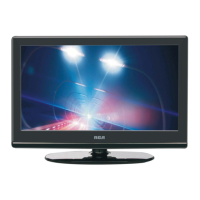
Do you have a question about the RCA RLC3708A-B and is the answer not in the manual?
| Screen Size | 37 inches |
|---|---|
| Display Technology | LCD |
| Aspect Ratio | 16:9 |
| Response Time | 8 ms |
| Speakers | 2 x 10W |
| Resolution | 1366 x 768 |
| Brightness | 500 cd/m2 |
| Inputs | HDMI, VGA, Component, Composite, RF |
Warnings about electric shock, opening the unit, and exposure to rain or moisture.
Guidance on operating conditions, airflow, and power cord management.
Caution regarding the danger of explosion if batteries are replaced incorrectly.
Warning about potential hazardous radiation exposure from improper use or adjustments.
Information on FCC rules and potential interference issues.
Instructions on reading manuals, cleaning, ventilation, and avoiding water.
Guidance on heat sources, ventilation, and avoiding damage to the unit.
Instructions on plug safety, grounding, and power cord protection.
Guidelines for using specified accessories and caution when moving the apparatus.
Instructions for servicing, unplugging during storms, and long periods of disuse.
Lists all items supplied with the TV, such as remote, batteries, and manuals.
Instructions on pointing the remote, ambient light effects, and battery installation.
Guidance on replacing weak batteries and notes on battery types and leakage.
Detailed explanation of each button's function on the remote control.
Identifies and explains the front-facing components like the screen, indicator, sensor, and speakers.
Details all input and output jacks located on the back of the TV for various connections.
Explains the functions of buttons located on the side of the TV for volume, channels, menu, etc.
How to connect TV signals from antennas, cable, or satellite systems.
Instructions for connecting VCRs, game systems, or camcorders using composite video and audio.
Connecting HD devices like cable boxes or satellite receivers using component video and audio inputs.
Connecting HD devices using the HDMI interface for digital video and audio.
Connecting a PC via VGA/D-SUB and audio cables, and connecting headphones.
Instructions for connecting the power cord and important safety notes related to power supply.
Guide on connecting to a home theater system, including Dolby Digital and digital output setup.
Step-by-step instructions for detaching and attaching the TV's base stand.
Guidelines for VESA-compliant wall mounting, including screw length requirements.
Advice on placing the TV on a stable surface and avoiding hazards like water or heat.
Steps for initial setup, including language selection and automatic channel search.
How to choose the input source for the TV, such as TV, AV, HDMI, or PC.
Options for adjusting picture quality like screen size, PC settings, color temperature, and advanced features.
Options for adjusting sound settings, including surround mode, AVL, and equalizer.
Options for managing channels, including lists, favorites, signal type, and auto search.
Features for setting program ratings, V-CHIP, and changing the password for content control.
Settings for closed captioning, menu language, clock, and other system preferences.
Options like blue background, power-off modes for no signal/operation, and reset.
Adjustments for brightness, contrast, color, tint, and sharpness for optimal viewing.
How to adjust the display aspect ratio to fit the screen based on the input source.
Details on PC settings that are only available when using the PC DB15 input mode.
How to select color temperature (Cool, Normal, Warm) for comfortable viewing.
Information on special picture features available in the advanced settings.
Explanation of different picture modes (Standard, Movie, User, Dynamic) for various conditions.
How to adjust the darkness and white level of the picture for optimal viewing.
How to adjust the color intensity and hue of the picture for desired output.
How to enhance object edges for better picture detail.
Detailed guide on adjusting PC display settings like auto-adjust, position, clock, and phase.
Explanation of advanced picture features like dynamic contrast, film mode, and noise reduction.
Adjusting sound modes, bass, treble, and balance for optimal audio experience.
Settings for virtual surround sound and automatic volume leveling (AVL).
Selecting sound tracks for analog and digital channels, including language options.
Configuring digital audio output and adjusting the 7-band equalizer settings.
Setting sound modes and adjusting bass, treble, and balance for customized audio.
Adjusting equalizer bands based on user preference for different frequency ranges.
Viewing all channels, selecting favorites, and setting channel labels.
Configuring channel skip/favorite status and setting the antenna signal type (Air/Cable).
Steps and description for initiating the automatic search for analog and digital channels.
Customizing channel viewing by skipping, adding to favorites, and renaming channels.
Locking programs, setting US/Canada V-CHIP ratings, and managing downloadable rating data.
Instructions for changing the parental control password.
Explanation of the US MPAA movie rating system and how to lock specific ratings.
Details on the TV rating system, including age-based and content-based ratings.
Information on English and French rating systems used in Canada for program content control.
Instructions for changing the password and accessing setup options like closed caption.
Configuring time zone, auto clock synchronization, setup time, and daylight saving.
Customizing the appearance of digital closed captions, including size, font, and colors.
Detailed configuration of time zones, auto clock synchronization, setup time, and daylight saving.
Configuring screen background, power-off modes for no signal/operation, and reset.
Table detailing resolutions, horizontal/vertical scanning frequencies, and formats for PC input.
Table listing resolutions, scanning frequencies, and formats for component and HDMI input.
Details on panel type, size, resolution, brightness, contrast, and system settings.
Information on various input/output ports and audio output specifications.
Details on power input voltage, frequency, and rated power consumption.
Solutions for common problems like bad picture quality, snow, distortion, and no sound.
Troubleshooting for issues like black and white picture, panel heat, unusual dots, and stripes.
Solutions for problems such as no picture/sound, unresponsive keys, and channel selection difficulties.